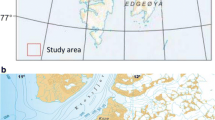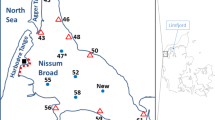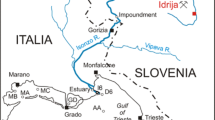Abstract
MOST of the mercury (up to 97%) found in aquatic systems is associated with bed sediments1. Fish, invertebrates and plants contain only 0.02% of the total, though they contain a high proportion of organic mercury. Field surveys show that the proportion of organic mercury in the sediments range from 0.1 to 2.1%2–6. Jacobs and Keeney placed river sediments mixed with inorganic mercury in the Wisconsin and Fox Rivers7. After 12 weeks exposure to the natural environment the concentration of methylmercury in the sediments was only 3%. This concentration of methylmercury was attained within 4 weeks after sediments were placed in the bottom of the rivers. This indicated that the processes of methylation and demethylation of mercury were in equilibrium in these environmental conditions within 4 weeks. But no experiments were conducted to show the degradation of methylmercury in sediments. After the methylation study by Jensen and Jernelöv8, many investigations into methylmercury production by microorganisms in bed sediments have been carried out. Little attention, however, has been paid to the ratio of methyl-mercury to the total mercury existing in the sediments. Spangler et al. observed degradation of methylmercury in mixed cultures from sediments9. The degradation reached 50% within 5 d, they also found methylmercury degradation in sediments. But detailed information about the sediments was not available and results fluctuated wildly. We do not know the total amount of methylmercury existing in all components of the systems, including fish, invertebrates and plants as well as various types of bed sediments. Here we use methylmercury equilibrium concentration levels in the Ottawa River sediments to estimate the amount of methylmercury in various types of bed sediment where detailed information of total mercury concentrations (total mercury estimation 31 kg) and types of sediment is available. Two ways (methylmercury production and degradation) of reaching equilibrium were observed during 50 d in identical environmental conditions.
Similar content being viewed by others
References
Kudo, A., Townsend, D. R. & Miller, D. R. Prog. wat. Tech. 9, 923 (1977).
Andren, A. W. & Harris, R. C. Nature 245, 256 (1973).
Batti, R., Magnaval, R. & Lanzola, E. Chemosphere 4, 13 (1975).
Langbottom, J., Pressman, R. & Lichtenburg, J. J. Ass. Off. analyt. Chem. 56, 1297 (1973).
Olson, B. H. & Cooper, R. C. Nature 252, 682 (1974).
Eganhouse, R. P. Southern California Coastal Water Research Proj. Rep. 83 (El Segundo, California, 1976).
Jacobs, J. W. & Keeney, D. R. J. environ. Quality 3, 121 (1974).
Jensen, S. & Jernelöv, A. Nature 223, 753 (1969).
Spangler, W. J., Spigarelli, J. L., Rose, J. M. & Miller, H. M. Science 180, 192 (1973).
Kudo, A., Townsend, D. R. & Miller, D. R. J. Am. Soc. Civil Engng. Env. Div. 103, EE4, 605 (1977).
Kudo, A., Akagi, H., Mortimer, D. C. & Miller, D. R. Environ. Sci. Technol. 11, 907 (1977).
Author information
Authors and Affiliations
Rights and permissions
About this article
Cite this article
KUDO, A., AKAGI, H., MORTIMER, D. et al. Equilibrium concentrations of methylmercury in Ottawa River sediments. Nature 270, 419–420 (1977). https://doi.org/10.1038/270419a0
Received:
Accepted:
Issue Date:
DOI: https://doi.org/10.1038/270419a0
- Springer Nature Limited
This article is cited by
-
Mercury and methylmercury in sediments and suspended particles from the river Elbe, North Germany
Water Air & Soil Pollution (1991)
-
Environmental fate of mercury discharged into the upper Wisconsin river
Water, Air, and Soil Pollution (1986)





